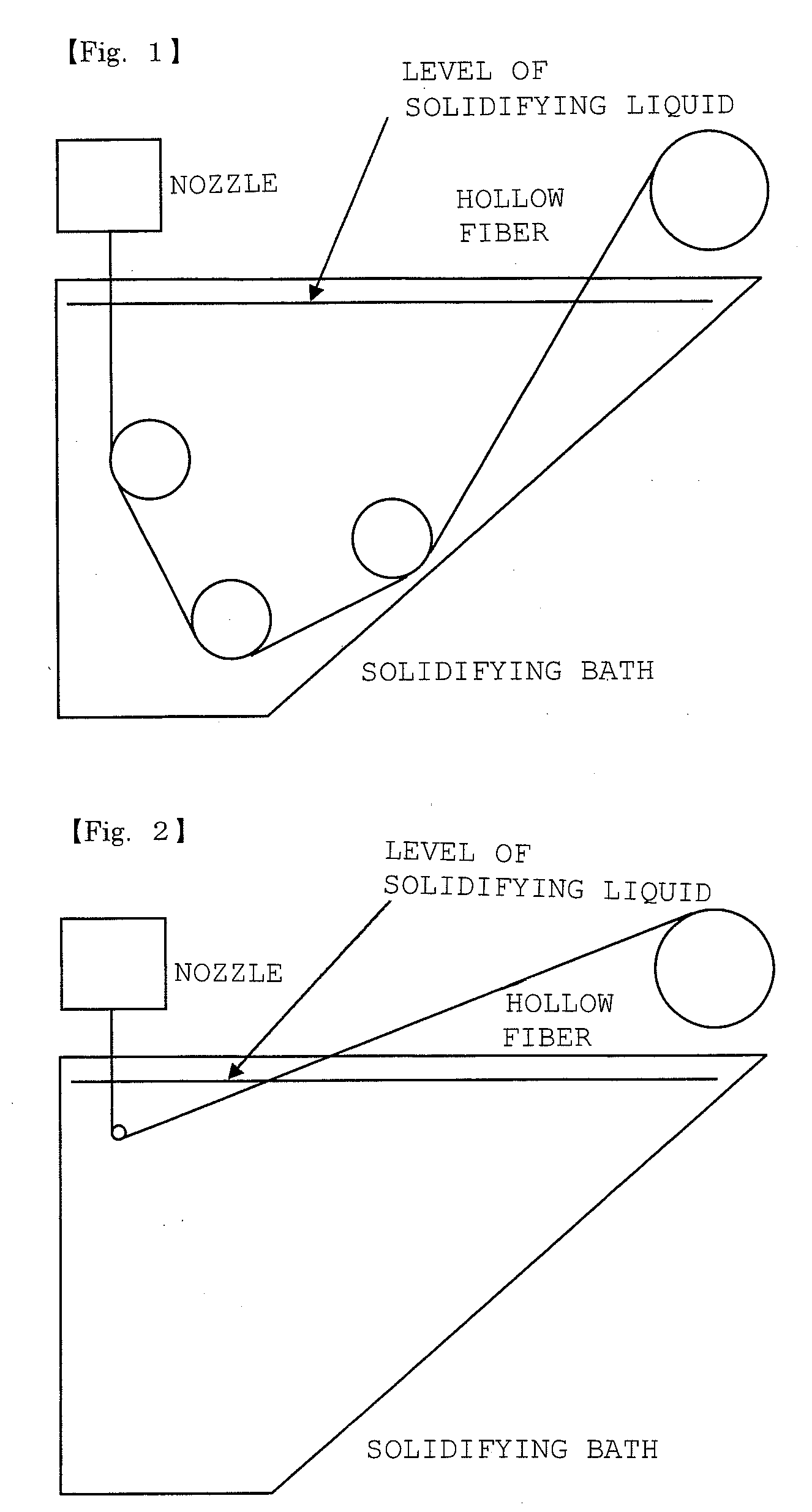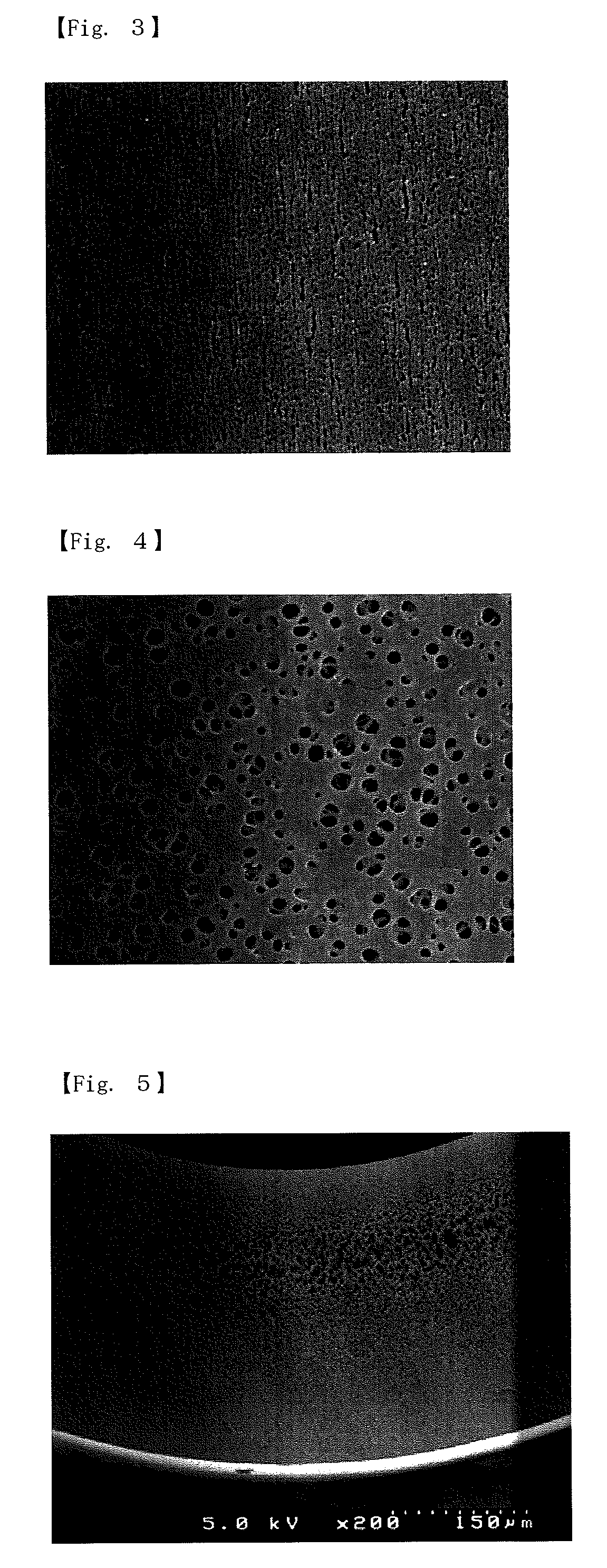Polymeric porous hollow fiber membrane
a hollow fiber membrane and polymer technology, applied in the field of polymeric porous hollow fiber membranes, can solve the problems of difficult to achieve a large flow amount, and clog the membrane, and achieve excellent membrane performance sustainability and membrane performance recoveryability, and high water permeability.
- Summary
- Abstract
- Description
- Claims
- Application Information
AI Technical Summary
Benefits of technology
Problems solved by technology
Method used
Image
Examples
example 1
[0173]PES (Sumika EXCEL® 4800P manufactured by Sumitomo Chem tech) (19.0 parts by weight), PVP (Kolidone® K30 manufactured by BASF) (3.0 parts by weight), NMP manufactured by Mitsubishi Chemical Corporation (35.1 parts by weight) and TEG manufactured by MITSUI CHEMICALS, INC. (42.9 parts by weight) were mixed and dissolved at 70° C. for 3 hours to form a homogenous solution. The system was decompressed at 70° C. from an atmospheric pressure to −700 mmHg. Immediately after that, the system was sealed so as not to change the composition of the solution due to the volatilization of the solvent or the like, and the solution was left to stand for 2 hours so as to be defoamed. The resulting solution was used as a membrane-forming solution. On the other hand, a mixture of NMP (35.1 parts by weight), TEG (42.9 parts by weight) and RO water (22.0 parts by weight) was prepared as a inner liquid. The membrane-forming solution and the inner liquid were discharged from the annular portion and th...
example 2
[0178]PSf (P-3500 manufactured by Amoco) (18.5 parts by weight), PVP (Kolidone® K30 manufactured by BASF) (3.5 parts by weight), NMP manufactured by Mitsubishi Chemical Corporation (35.1 parts by weight) and TEG manufactured by MITSUI CHEMICALS, INC. (42.9 parts by weight) were mixed and dissolved at 70° C. for 3 hours to form a homogenous solution. The system was decompressed at 70° C. from an atmospheric pressure to −700 mmHg. Immediately after that, the system was sealed so as not to change the composition of the solution due to the volatilization of the solvent or the like, and the solution was left to stand for 2 hours so as to be defoamed. The resulting solution was used as a membrane-forming solution. On the other hand, a mixture of NMP (35.1 parts by weight), TEG (42.9 parts by weight) and RO water (22.0 parts by weight) was prepared as a inner liquid. The membrane-forming solution and the inner liquid were discharged from the annular portion and the center portion of a doub...
example 3
[0187]PES having hydroxyphenyl groups at its ends (Sumika EXCEL® 4800P manufactured by Sumitomo Chemtech) (19.2 parts by weight), PVP (Kolidone® K30 manufactured by BASF) (2.8 parts by weight), NMP manufactured by Mitsubishi Chemical Corporation (35.1 parts by weight) and TEG manufactured by MITSUI CHEMICALS, INC. (42.9 parts by weight) were mixed and dissolved at 70° C. for 3 hours to form a homogeneous solution. The system was decompressed at 70° C. from a normal pressure to −700 mmHg, and the system was then immediately sealed so as not to change the composition of the solution due to volatilization of the solvent or the like. The solution was left to stand in this state for 2 hours to be defoamed. The resultant solution was used as a membrane-forming solution. On the other hand, a mixture of NMP (35.1 parts by weight), TEG (42.9 parts by weight) and RO water (22.0 parts by weight) was prepared as a inner liquid. The membrane-forming solution and the inner liquid were discharged ...
PUM
| Property | Measurement | Unit |
|---|---|---|
| surface area | aaaaa | aaaaa |
| pore diameter | aaaaa | aaaaa |
| pore diameter | aaaaa | aaaaa |
Abstract
Description
Claims
Application Information
 Login to View More
Login to View More - R&D
- Intellectual Property
- Life Sciences
- Materials
- Tech Scout
- Unparalleled Data Quality
- Higher Quality Content
- 60% Fewer Hallucinations
Browse by: Latest US Patents, China's latest patents, Technical Efficacy Thesaurus, Application Domain, Technology Topic, Popular Technical Reports.
© 2025 PatSnap. All rights reserved.Legal|Privacy policy|Modern Slavery Act Transparency Statement|Sitemap|About US| Contact US: help@patsnap.com



